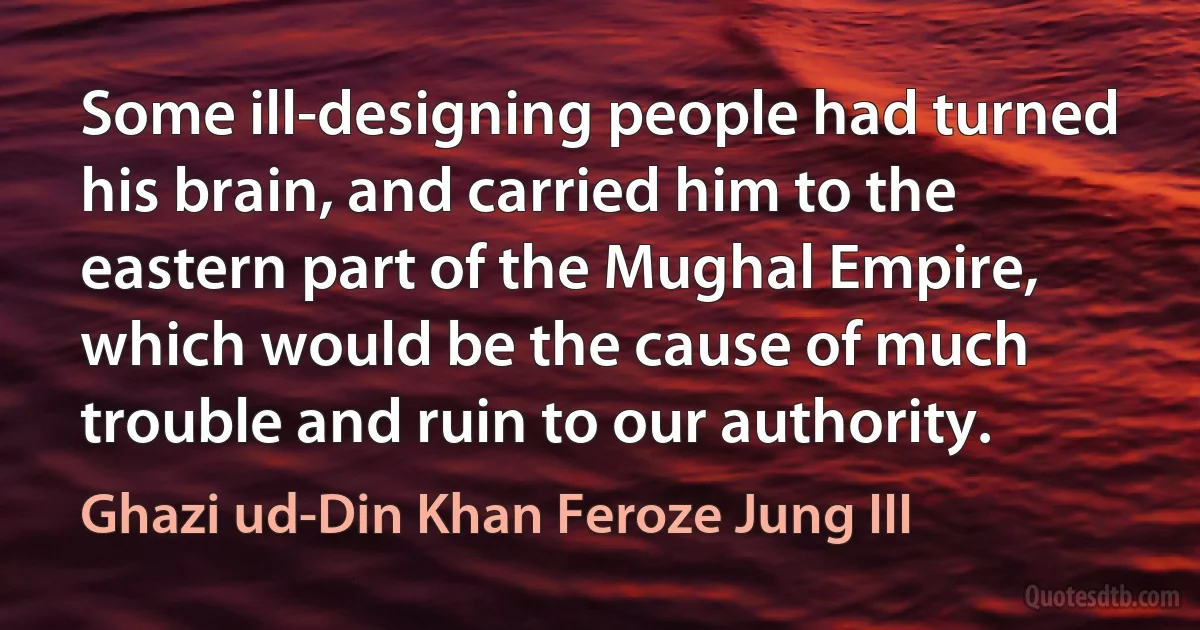Mughal Quotes
Bernier says that the Rajput "Rajas never mount (guard) within a (Mughal) fortress, but invariably without the walls, under their own tents... and always refusing to enter any fortress unless well attended, and by men determined to sacrifice their lives for their leaders. This self devotion has been sufficiently proved when attempts have been made to deal treacherously with a Raja.”.

François Bernier
Contrary to what is sometimes claimed in the press, there are many fine historians in India. From my own generation of scholars, I can strongly recommend - to student and lay reader alike - the work of Upinder Singh on ancient India, of Nayanjot Lahiri on the history of archaeology, of Vijaya Ramaswamy on the bhakti movement, of Sanjay Subrahmanyam on the early history of European expansion, of Chetan Singh on the decline of the Mughal State, of Sumit Guha on the social history of Western India, of Seema Alavi on the social history of medicine, of Niraja Gopal Jayal on the history of citizenship, of Tirthankar Roy on the economic consequences of colonialism, of Mahesh Rangarajan on the history of forests and wildlife, and of A. R. Venkatachalapathy on South Indian cultural history.

Ramachandra Guha
The Mughal rulers of the Punjab were evidently concerned with the growth of the Panth, and in 1605 the Emperor Jahangir made an entry in his memoirs, the Tuzuk-i-Jahāṅgīrī, concerning Guru Arjan's support for his rebellious son Khusrau Mirza. Too many people, he wrote, were being persuaded by his teachings, and if the Guru would not become a Muslim the Panth had to be extinguished. Jahangir believed that Guru Arjan was a Hindu who pretended to be a saint, and that he had been thinking of forcing Guru Arjan to convert to Islam or his false trade should be eliminated, for a long time. Mughal authorities seem plainly to have been responsible for Arjan's death in custody in Lahore, and this may be accepted as an established fact. Whether death was by execution, the result of torture, or drowning in the Ravi River remains unresolved. For Sikhs, Arjan is the first martyr Guru.

Guru Arjan
But with the passing of time, a peasant became a tribal and from tribal a beast. William Finch, writing at Agra about 1610 C. E., describes how Jahangir and his nobles treated them - during Shikar. A favourite form of sport in Mughal India was the Kamargha, which consisted in enclosing a tract of country by a line of guards, and then gradually contracting the enclosure until a large quantity of game was encircled in a space of convenient size. "Whatever is taken in this enclosure” (Kamargha or human circle), writes Finch, "is called the king's shikar or game, whether men or beasts... The beasts taken, if man's meat, are sold... if men they remain the King's slaves, which he sends yearly to Kabul to barter for horses and dogs: these being poor, miserable, thievish people, that live in woods and deserts, little differing from beasts.”89 W. H. Moreland adds: "Other writer (also) tell it besides Finch.”.

Jahangir
It was the sufi saints who initiated the struggle for the establishment of an Islamic state in India. Khwaja Muinuddin Chisti, Khwaja Nizamuddin Aulia and Bakhtiyar Kaki opposed the secularist policies of the kings of the slave dynasty of medieval India. Mujadid al-Thani Ahmed Sirhindi organized a resistance movement against the Mughal Emperor Akbar and his attempts to establish a secular Indian polity. The Mujidid's disciples and devotees included Akbar's great-grandson, the dervish Prince Aurangzeb Alamgeer.

Ahmad Sirhindi
The Hindus' sense of gratitude knows no bounds to Muslim rulers like Zayn al-‘Abidin (1420-70) of Kashmir, ‘Alau d-Din Husayn Shah (1493-1519) of Bengal, and Akbar the Great Mughal, who behaved towards Indians as Indians and at whose hands they could heave a sigh of relief from religious persecution. The three rulers tried their utmost to Indianize their rule and restore the dignity of Hindu community and culture, the latter essaying the uphill task of integrating Islam therewith, followed in this behalf by Prince Dara Shukoh. Who that has even the faintest sense of history can dispute the point that they were all intensely Indian, putting many a Hindu to shame in their patriotic fervour.

Alauddin Husain Shah
The Hindus' sense of gratitude knows no bounds to Muslim rulers like Zayn al-‘Abidin (1420-70) of Kashmir, ‘Alau d-Din Husayn Shah (1493-1519) of Bengal, and Akbar the Great Mughal, who behaved towards Indians as Indians and at whose hands they could heave a sigh of relief from religious persecution. The three rulers tried their utmost to Indianize their rule and restore the dignity of Hindu community and culture, the latter essaying the uphill task of integrating Islam therewith, followed in this behalf by Prince Dara Shukoh. Who that has even the faintest sense of history can dispute the point that they were all intensely Indian, putting many a Hindu to shame in their patriotic fervour.

Dara Shukoh
Like any other imperialism, Muslim and British Imperialisms also created a class of mercenaries and compradores - and here I am talking of intellectual mercenaries; they created a collaborationist tradition or school which endured even after the rulers had left. Marxist historians, for example, belong to the school of Hindu munshis whom the Mughal kings employed to eulogize their rule and their religion, and who wrote servilely to flatter their patrons and whose writings failed to reflect even remotely the feelings, fears, hopes and yearnings of their own subject fellow brothers.

Ram Swarup
Three conclusions can be safely drawn from a study of these 21 inscriptions. Firstly, the destruction of Hindu temples continued throughout the Muslim rule, from the date of its first establishment at Delhi in AD 1192 to its downfall with the death of the Mughal emperor Muhammad Shah in 1748. Secondly, the destruction took place all over India and was undertaken by rulers belonging to all Muslim dynasties, imperial as well as provincial. Thirdly, the destruction had no economic or political motive as has been proposed by Marxist scholars and Muslim apologists; it was inspired by religious zeal and regarded as a pious performance by Muslim kings and commanders, all of whom took considerable pride in it and sought blessing from Allãh and the Prophet. The iconoclasts, it may be added, have been idolised all along as paragons of faith, virtue, justice and generosity. These conclusions become clearer still when we come to evidence from Islamic literary sources.

Sita Ram Goel
Mir Jumla made his way into Kuch Bihar by an obscure and neglected highway' In six days the Mughal army reached the capital (19th December) which had been deserted by the Rajah and his people in terror. The name of the town was changed to Alamgirnagar; the Muslim call to prayer, so long forbidden in the city, was chanted from the lofty roof of the palace, and a mosque was built by demolishing the principal temple.

Aurangzeb
I've spent a lot of time in London over the last few years and I liked the idea of the Mughal emperor Babur meeting with modern-day disaffected youth and talking to them about their actions. He was a sharp literary critic who could be very sweeping and cruel about poetry if he thought it was bad poetry, and he said some fantastic things that I quoted word for word in the opera. I read the Baburnama – the memoirs of Babur – and quoted lines from it. "Writing badly will make you ill.” What a beautiful thing to say. I read that book and I thought, how dramatic! If he had been a figure in western history it would have been an opera. War, murder, love, tragedy, poetry. It always jumped out at me as something worth doing.

Jeet Thayil
The outbreak revealed the surprising degree to which the Mughal court was still regarded across northern India not as some sort of foreign Muslim imposition – as some, especially on the Hindu right wing, look upon the Mughals today – but instead as the principal source of political legitimacy, and therefore the natural centre of resistance against British colonial rule.

William Dalrymple (historian)
"Yachappa Nayak, the Hindu noble to whom I have referred earlier in my narrative, on seeing that the Mughal army after repeated orders from the Emperor, was bent on the destruction of the Hindu temples, left Mughal service and entered the territory of Gingee with his men. From there, he wrote to all the Hindu Princes, urging them to unite against the enemy of their community and religion.” ( p. 1256)

Aurangzeb
In the past twenty years, he has rigorously pursued fascination for [India], writing one brilliant travel book (City of Djinns: A Year in Delhi), two vivid histories (White Mughals and The Last Mughal), and one anthology of acute acute journalism (The Age of Kali) about South Asia. He came to India before it had achieved its status as a frontier boomland for computer programmers and writers alike, and he has lived there, on and off, since 1989... he has become something of a godfather to a generation of writers who are producing nonfiction about the country. The fact that Dalrymple looks like a sunnier version of the actor James Gandolfini and loves to party no doubt helps with this reputation.

William Dalrymple (historian)


